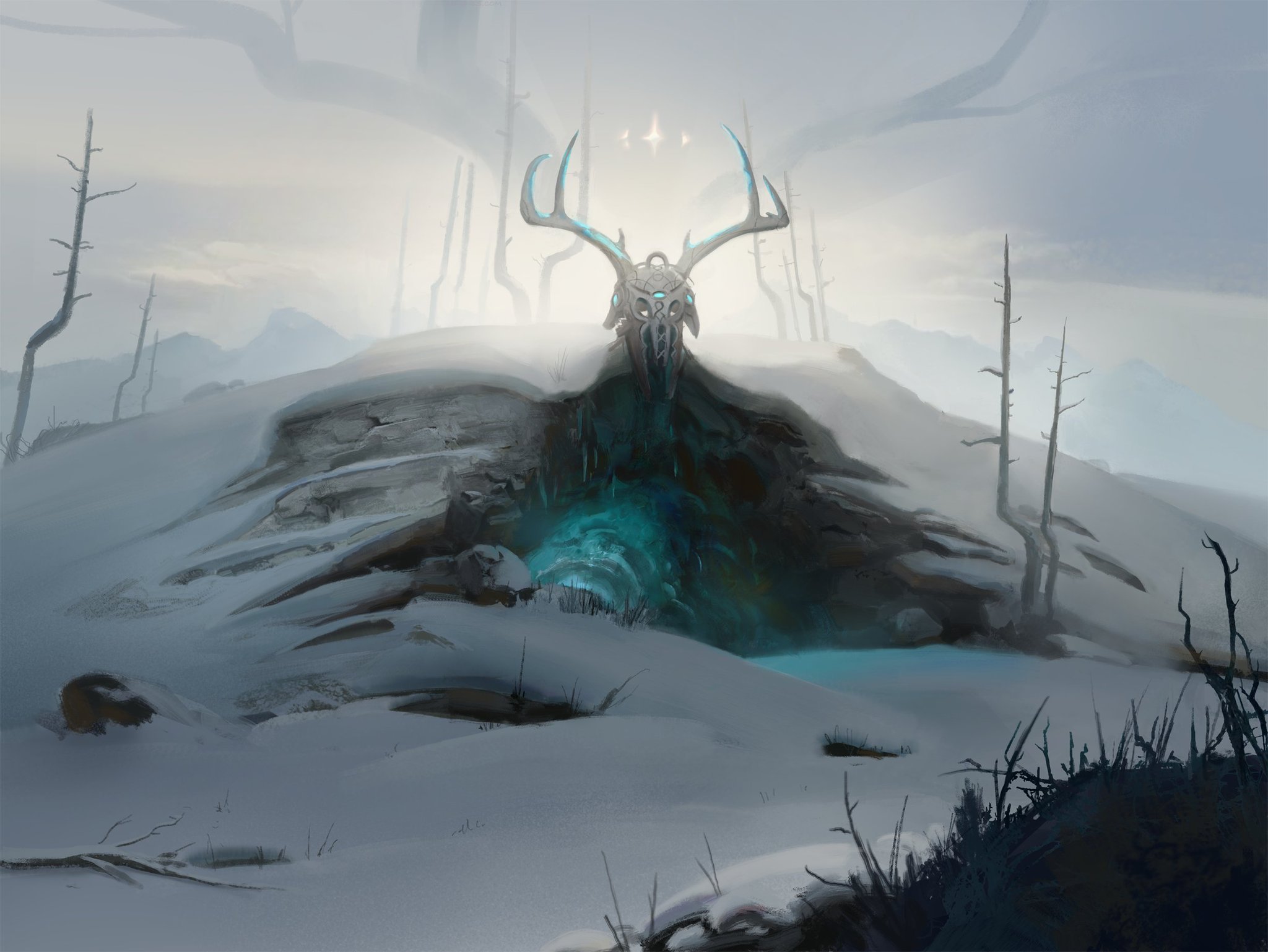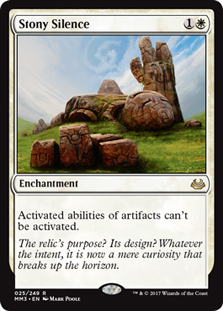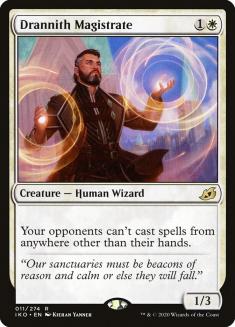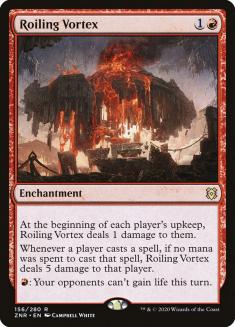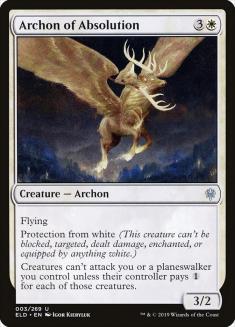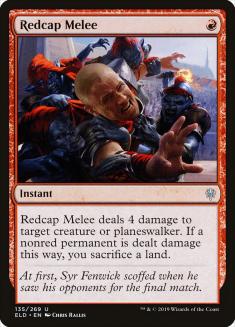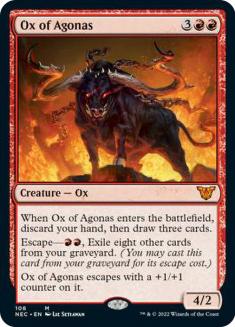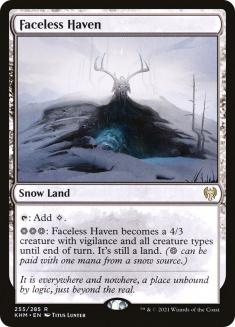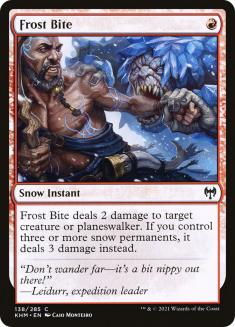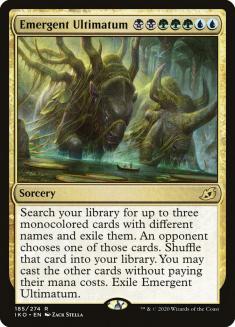For the past couple of weeks, I’ve been testing Kaldheim Standard in preparation for the second weekend of the MPL Kaldheim Split. During my testing, I discovered several interesting things about the format — even though the decks are similar to those of Zendikar Rising Standard, I think the dynamics of Kaldheim Standard are quite different and worth a deep dive into for anyone who wants to succeed in the format.
In today’s article, I’ll give you my current overview of the Kaldheim Standard format. I will start by talking about the characteristics that I consider central to it, which will form the bulk of my analysis, followed by the list of decks I consider Tier 1 and Tier 2 and their good and bad matchups, as well as my pick for this weekend’s MPL split.
There are many viable decks on all sides of the spectrum.
Previously, I felt like Zendikar Rising Standard was relatively diverse, but Kaldheim Standard is even more so. There was, for example, a distinct lack of “small aggro,” with Gruul Adventures encompassing basically the entire metagame share of the aggressive decks.
This format, on the other hand, has two different small aggro decks (Mono-White Aggro❄ and Mono-Red Aggro❄) and at least four distinct midrange aggro decks (Gruul Adventures, two takes on Naya Adventures, and Rakdos Sacrifice). It also has several different versions of Yorion decks (Esper Blink, Sultai Ramp, Four-Color Blink) as opposed to simply Esper, two aggro-control decks (Dimir Rogues (Lurrus) and Izzet Midrange) and so on. In a ten-round tournament, you could easily never play more than twice against the same matchup, which was almost an impossibility in the previous format when decks were far more condensed.
Matchups are highly polarized.
In Zendikar Rising Standard, there were good and bad matchups but they were always close. I felt like Dimir Rogues was a small favorite versus Gruul Adventures before sideboard and a small dog after sideboard, that Esper Blink (Yorion) was a small dog to Dimir Rogues and a small favorite against Gruul Adventures, etc. The games always had a ton of play to them and matchups rarely went further than 55% in either direction, so there was not a lot of pressure to guess what you were going to play against — even if you played versus five bad matchups in a row, these matchups were never bad enough that you felt you couldn’t overcome them; they were only slight nuisances.
In Kaldheim Standard, the opposite happens — almost no matchups are close. Dimir Rogues is a huge favorite versus Mono-White Aggro❄ and a huge dog to Mono-Red Aggro❄; Rakdos Sacrifice is a huge favorite versus Dimir Rogues and a huge dog to Sultai Ramp (Yorion); Sultai Ramp is a huge favorite versus Rakdos Sacrifice and a huge dog to Dimir Rogues. There are certainly variations among the decks, but as a general rule you will be much more punished by queueing into a bad matchup and much more rewarded by playing a good one in this format than in the previous format.
Sideboard cards are all Stony Silences.
When testing, we referred to a card that was only good versus one specific matchup yet was strong enough to swing that matchup as a “Stony Silence.” The previous format only had one Stony Silence, and that was Ox of Agonas against Dimir Rogues — even then, that was a card that was useful against a wide variety of decks (such as control and grindy opponents like Rakdos Sacrifice), so I would hesitate to call it a Stony Silence though it did swing matchups against Dimir Rogues. Right now, there are way more Stony Silences in the field.
To give you an example, let’s look at a sideboard from Gruul Adventures from Zendikar Rising Standard:
- 1 Klothys, God of Destiny
- 2 Vivien, Monsters’ Advocate
- 3 Thrashing Brontodon
- 1 Soul Sear
- 2 Fire Prophecy
- 3 Ox of Agonas
- 2 Phoenix of Ash
- 1 Scorching Dragonfire
This is Gabriel Nassif’s sideboard from the last Standard MPL Split, and here you can see that the sideboard cards are extremely generic. There are a variety of removal spells, ways to destroy artifacts and enchantments, extra resilient threats versus decks that try to grind you out, and escape cards versus Dimir Rogues. Some people played Wilt and some played The Akroan War, but these are all cards that complement what your deck is trying to do in a matchup rather than becoming the focal plan for winning a matchup — none of them, apart from maybe Ox, is a Stony Silence.
Now, let’s look at this sideboard that we were seriously considering for a Naya deck at some point this week:
- 3 Drannith Magistrate
- 3 Ox of Agonas
- 3 Archon of Absolution
- 1 Redcap Melee
- 2 Scorching Dragonfire
- 3 Roiling Vortex
Outside of Scorching Dragonfire, this sideboard is all Stony Silences!
- Drannith Magistrate is almost exclusively for Naya Adventures since it shuts down all their Adventures and Showdown of the Skalds. It’s very hard for that deck to win while this is on the battlefield
- Roiling Vortex is exclusively for Sultai Ramp. It’s not even good versus other Sultai or Yorion decks. The sole goal of the card is to stop Emergent Ultimatum from being cast.
- Archon of Absolution is strictly for Mono-White Aggro❄ and it’s also very hard for them to win if this card is on the battlefield. It’s unblockable, it blocks anything, and you can’t really attack during half the turns. Seriously, what is protection from a color doing in Standard again?
- Redcap Melee is targeted at Mono-Red Aggro❄ decks, and, while it does have specific applications outside of that (such as killing Goldspan Dragon from Naya Adventures), in a different format we might end up playing a different removal spell.
- Ox of Agonas is not exclusively against Dimir Rogues but it is mainly a bullet against Dimir Rogues, as our deck was not fast enough that it would want a lot of Oxen against most other decks. The third Ox, for example, is exclusively versus Dimir Rogues.
This is a radical departure from the previous situation we had, where you could reasonably sideboard eight-plus cards against any deck but they would be upgrading your five-out-of-tens into sevens for the matchup. With a sideboard like this, you are going to bring in three cards versus everybody and they will turn your fives into tens.
You can’t trust the matchup matrixes blindly.
Data in MTG is a weird thing. It’s very valuable if it’s correct, but you must take it with a grain of salt (or several grains of salt). It used to be that high-level players would mostly ignore data, which I think was a mistake, but nowadays it feels like we’ve done a complete 180 and now we value data over everything and that’s also a mistake.
The first issue is that sample sizes are usually too small, at least for us to get a significant idea of what’s happening. The second is that there are a lot of variables that are not included in the data, most important of which are differences between versions of the same deck and the skill of the pilots.
In the weeks before the Zendikar Rising Championship, every chart I saw had Dimir Rogues as having a bad matchup versus Mono-Green Food over a relatively large sample size. I saw several articles written that cited this number and said, “You don’t want to play Dimir Rogues because Mono-Green Food is a bad matchup.”
Yet, most pros disagreed with these conclusions. When the tournament came, Dimir Rogues actually had a positive win rate versus Mono-Green Food. It turns out the deck is just very hard to play properly, and that matchup even more so, which meant that the data acquired by less experienced players did not match the outcome when the deck was played by more skilled pilots.
Sometimes, this explanation is good enough and makes sense. Other times, there’s simply no explanation that I can find. For example, take a look at this chart from a tournament that happened this past week:
This just subverts every expectation I had about this Standard format. Take a look at Dimir Rogues. It’s not positive in any matchup, except for Rakdos Sacrifice! It’s almost like this is some bizarro tournament and the entire chart is flipped. Mono-White Aggro❄ is showing as a 35% deck versus Mono-Red Aggro❄ when I believe it’s favored versus it, but as a 57% deck against both Dimir Rogues and Rakdos Sacrifice, which are its two worst matchups! Rakdos Sacrifice, on the other hand, is losing to its two best matchups but has a 62% win rate versus Sultai Ramp, which is the deck that drove it out of the metagame to begin with.
Obviously this is just one tournament, but stuff like this happens every time. If you look at this chart and take this at face value, you will have a completely warped idea of what’s happening in Kaldheim Standard. Either that, or I have a completely warped idea of what’s happening, but I hope it’s not the latter.
So, after all is said and done, where does this leave us?
Tier 1
Mono-Red Aggro❄
Creatures (28)
- 4 Robber of the Rich
- 4 Fervent Champion
- 4 Bonecrusher Giant
- 3 Torbran, Thane of Red Fell
- 4 Rimrock Knight
- 4 Anax, Hardened in the Forge
- 1 Phoenix of Ash
- 4 Fireblade Charger
Lands (23)
Spells (9)

Mono-Red Aggro❄ has been a fixture forever, but right now it’s arguably better than it has been since the Hazoret the Fervent times. The new additions to the deck might be innocuous but they’re much stronger than they appear, as Frost Bite is incredible versus the aggressive decks and Faceless Haven is incredible against everyone else.
Faceless Haven is especially good in this deck because it’s the one that best makes use of the changeling part — pumping it with Fervent Champion and using it to cast Robber of the Rich cards come up a lot. Robber of the Rich also got better, as more decks became aggressive and their cards became cheaper — not cheap enough that they will have fewer cards than you but cheap enough that you’ll actually want to cast them on Turns 3 or 4.
Mono-Red Aggro❄ is, ironically enough, the safest option among the good decks because I feel it only has one bad matchup (Mono-White Aggro❄) among the popular choices. And even that one is not truly bad, just unfavorable. In the previous format, we had Gruul Adventures as the safe option — no matter what anyone else was doing, you would never be under 45% as there was just no card that was even particularly good against specifically you — and while this is not true for any deck here, it’s most true of Mono-Red Aggro❄.
The big difference from this season to the past season in terms of matchups is the Gruul Adventures matchup. Nowadays, I feel like Lovestruck Beast is not as big a problem as it was before, because Frost Bite lets you more easily trade with it. You can combine it with Stomp to get rid of it, you can finish it off in combat, or you can even just Frost Bite it with Torbran, Thane of Red Fell on the battlefield. This, combined with the fact that Mono-Red Aggro❄ is just a better deck now, makes the matchup not as lopsided as it used to be — not favorable, but only slightly unfavorable in my opinion.
In my opinion, Mono-Red Aggro❄ is:
- Very favored versus Dimir Rogues (Lurrus)
- Favored versus Sultai Ramp (Yorion)
- Favored versus Naya Adventures
- Slightly unfavored versus Gruul Adventures
- Unfavored versus Mono-White Aggro❄
- Slightly unfavored versus hateful lists of other Yorion decks (such as Esper Blink) but favored versus lists of those decks that are not trying to beat Mono-Red
The Rakdos Sacrifice matchup is still a mystery to me at this point.
Mono-White Aggro❄
Creatures (32)
- 3 Giant Killer
- 3 Alseid of Life's Bounty
- 4 Seasoned Hallowblade
- 4 Selfless Savior
- 4 Skyclave Apparition
- 4 Luminarch Aspirant
- 4 Halvar, God of Battle
- 3 Usher of the Fallen
- 3 Reidane, God of the Worthy
Lands (24)
Spells (4)

Mono-White Aggro❄ had an incredible week a week ago, but most accounts I saw assumed it was going to be a flash-in-the-pan kind of situation — after all, the success it had that week was the product of everyone tuning their decks to beat Sultai Ramp, and the deck is certainly beatable (there’s literally a card in the format that just beats it most games). I do not agree with this assessment for three reasons.
- The deck is more inherently powerful than it looks and not just a metagame choice. When everyone was playing Negates, Disdainful Strokes, and Mystical Disputes in the maindeck, it crushed the tournaments, but I don’t think it requires those things to be true for it to be a playable deck. They kept releasing powerful white aggressive cards and at some point they were bound to all team together and become a deck. I think that time is now. (CEDitor’s Note: Sing sweet nothings to me PV!)
- The deck is not that weak to adaptation. If you simply cut two cards from your deck for two more removal spells, that’s not going to cut it. Faceless Haven and Reidane, God of Justice gave it powerful options against mass removal, and the duo of Selfless Savior and Alseid of Life’s Bounty that has been protecting creatures from spot removal since 2020 does good work here as well. You can beat the deck, but you need to really want to do that.
- No one wants to do that. This is a format with many, many different decks in it, and some of the cards that I would consider “must plays” in your sideboard (such as Ox of Agonas) do not necessarily have wide applications. If you want to play Archon of Absolution, that’ll be a real cost, because Mono-White Aggro❄ might be 7% of the metagame when all is said and done. I read a lot of articles/analysis/comments about Standard and most of them seemed to say “Mono-White Aggro❄ is vulnerable to people who want to beat it; therefore it will not be an important deck moving forward”, but these same people would then post their decklists and not include the cards necessary to beat it! It makes sense — if you think the deck won’t be heavily played moving forward, then you don’t want to dedicate cards do it — but this creates a sort of prisoner’s dilemma scenario in which everyone is just hoping everyone else will beat the deck for them and no one wants to actually put in the work, because the work to beat it makes your deck worse everywhere else.
The main issue for Mono-White Aggro❄ in the grand scheme of things is that it’s not so different to Mono-Red Aggro❄, so you can never catch people entirely off-guard. If they expect to play against Mono-Red Aggro❄ (and they should), then they will always have cards against you. But they might not be the best cards — it’s certainly better to play against Scorching Dragonfire than against Glass Casket as the white player, for example, not to mention the difference between something like Redcap Melee and Archon of Absolution.
In my opinion, Mono-White Aggro❄ is:
- Favored versus Mono-Red Aggro❄
- Unfavored versus Dimir Rogues (Lurrus)
- Favored versus Sultai Ramp (Yorion)
- Unfavored versus most Esper-based Yorion decks
- Unfavored versus Rakdos Sacrifice
- Favored versus Naya Adventures
- Favored versus Gruul Adventures
Sultai Ramp (Yorion)
Creatures (3)
Lands (33)
Spells (44)

Sultai Ramp (Yorion) is the deck that, in my opinion, loses to the most popular decks but beats everything else. If I look at a metagame of Mono-White Aggro❄ and Mono-Red Aggro❄, I don’t want to play Sultai Ramp. But if I look at a metagame of decks tuned to beat those two, I very much want to, as there’s nothing you can do to your deck to be better versus the aggressive decks that won’t make you much worse versus Sultai.
Sultai is also much more customizable than the previous two decks, which I believe have to stay mono-colored due to Faceless Haven and therefore don’t have many flexible slots — they’re simply playing the best 60 aggressive cards in their colors and if there were any other playable card they would be playing it instead. There are a couple of slots that can change from list to list, but they mostly remain the same. With Sultai, you’re allowed infinite customization. Regardless of what you do, though, I think the versions with Emergent Ultimatum are better than the ones without.
Personally, I tried to build my Sultai Ramp decks to beat the aggro decks and I did not succeed. I was still going even at best with them and my deck was so warped towards beating them that I felt I’d no longer be able to compete with many of the decks that should have been easy matchups before. However, someone could easily have found a version of Sultai that retains its core identity of having an “I win!” button versus midrange decks while being competitive with the aggro decks, and if such a deck was found, it might be the best deck in the field.
In my opinion, Sultai Ramp (Yorion) is:
- Unfavored versus Mono-Red Aggro❄
- Unfavored versus Mono-White Aggro❄
- Unfavored versus Dimir Rogues (Lurrus)
- Favored versus Naya Adventures
- Favored versus Gruul Adventures
- Favored versus other Yorion decks
- Very favored versus Rakdos Sacrifice
Tier 2
Dimir Rogues (Lurrus)
Creatures (15)
Lands (22)
Spells (23)

Dimir Rogues (Lurrus) is in a bit of a pickle. I love the deck, and it fits my playstyle really well, but the metagame just doesn’t seem super right for it. It struggles with Ox of Agonas out of every single red deck, and Mono-Red Aggro❄ is a deck that’s almost forced to play Ox due to a lack of better sideboard cards (on top of usually having Phoenix of Ash as well).
There’s some disrespect given to Dimir Rogues since it’s a worse deck now — people won’t have as many escape cards as they did before and they won’t play as many Klothys, God of Destiny as well — but the red decks are still enough of a problem that I believe Dimir Rogues cannot be Tier 1 while they remain the most popular deck. I no longer think Dimir Rogues is just a “good deck” but a “metagame deck” — it preys on both Mono-White Aggro❄ and Sultai Ramp, so if both these decks become way more popular than the red decks it will be a good choice, but if you choose it for a tournament, you need to know that there’s a reasonable chance you get paired versus a lot of bad matchups.
In my opinion, Dimir Rogues (Lurrus) is:
- Very unfavored versus Mono-Red Aggro❄
- Favored versus Mono-White Aggro❄
- Favored versus Sultai Ramp (Yorion)
- Unfavored versus Naya Adventures
- Unfavored versus Gruul Adventures
- Favored versus the Yorion decks
- Very unfavored versus Rakdos Sacrifice (though I’ve seen some versions without Kroxa, Titan of Death’s Hunger, so if people start doing that it becomes better)
Naya Adventures
Creatures (24)
- 4 Lovestruck Beast
- 4 Giant Killer
- 4 Edgewall Innkeeper
- 4 Bonecrusher Giant
- 4 Shepherd of the Flock
- 4 Goldspan Dragon
Lands (20)
Spells (16)

There are currently two different Naya Adventures decks — one that is like Gruul Adventures but splashing white for Showdown of the Skalds, and one that plays the combo of Goldspan Dragon, Unleash Fury, and Kazuul’s Fury like you see above.
When I first saw the new version of Naya Adventures above, I assumed it was sort of a meme but it actually played out much better than I expected and it’s my favorite Naya deck right now. I’m not a fan of the normal Naya Adventures build, as I don’t think Showdown of the Skalds is that good as an aggressive piece — I want a card that helps my gameplan of killing them now, not one that does it in one or two turns. The Goldspan Dragon version, on the other hand, is much better at utilizing the card, as it’s legitimately a combo piece that enables easy Turn 5 kills (Turn 4 Showdown of the Skalds, Turn 5 Goldspan Dragon + two Unleash Furies is enough).
One issue with this deck is that Drannith Magistrate is very strong against it. It stops the Adventure creatures and also your main engine in Showdown of the Skalds while dodging Bonecrusher Giant and Giant Killer. The counterpoint is that you can run Archon of Absolution yourself.
In my opinion, this deck is:
- Unfavored versus Mono-Red Aggro❄
- Unfavored versus Mono-White Aggro❄
- Unfavored versus Sultai Ramp (Yorion)
- Favored versus Dimir Rogues (Lurrus)
- Favored versus other Yorion decks
- Favored versus Rakdos Sacrifice
- Favored versus Gruul Adventures
Gruul Adventures
I thought Gruul Adventures was a very strong deck before, but right now I don’t really see the point in playing it. I think it’s weak versus several of the top decks while not being strong enough against the others to make up for it. Dimir Rogues and Mono-Red Aggro❄ are two good matchups, but they aren’t as good as they used to be because Mono-Red Aggro❄ got better and you need to dedicate more sideboard cards for Dimir Rogues than you can afford.
Gruul Adventures also had very strong sideboard plans — you could configure your deck in any way you wanted in any matchup and that was quite valuable. Now you’re forced to play more specific cards, such as Roiling Vortex to be able to beat Sultai Ramp, which cuts into your ability to sideboard in eight cards in every matchup.
Personally, I believe Gruul Adventures is mostly a worse version of the new version of Naya Adventures — you’re only slightly better versus Mono-Red Aggro❄ but I think you are worse versus everyone else.
In my opinion, Gruul Adventures is:
- Slightly favored versus Mono-Red Aggro❄
- Unfavored versus Mono-White Aggro❄
- Unfavored versus Sultai Ramp (Yorion)
- Unfavored versus Naya Adventures
- Favored versus Rakdos Sacrifice
- Unfavored versus the Yorion decks
- Favored versus Dimir Rogues (Lurrus)
Esper Blink (Yorion)
Creatures (10)
Lands (27)
Spells (43)

I’m using Esper Blink (Yorion) here to basically mean “Yorion decks that are not Sultai Ramp,” whether they’re Esper, Four-Color or another variation.
I think Yorion decks are one of two decks I wish I had worked on more before this split, as they seem like they have the tools to beat the aggressive decks and the aggressive decks are going to be most of the field. The white cards are particularly well-positioned — Skyclave Apparition, Archon of Sun’s Grace, Omen of the Sun, Glass Casket, and The Birth of Meletis are all better now than they used to be. Archon of Sun’s Grace, in particular, interests me, as it dodges Giant Killer, Bonecrusher Giant, Glass Casket, and Frost Bite, and it generates enough blockers to stop Goldspan Dragon from doing its job. I suspect that most Esper Blink decks should maindeck three of four of that card, as it’s quite strong.
I think this deck is in a similar position to Sultai Ramp in that you can build it to beat anything you want, but, contrary to Sultai, it will actually beat the aggressive decks for the most part if this is your focus (but you will still lose to all the other decks while doing so, so there’s always a trade-off).
Another bad thing this deck has going for it is that Gruul Adventures was a good matchup, but Naya Adventures is not. Showdown of the Skalds is quite strong versus you and better than anything Gruul Adventures would have in that spot.
In my opinion, Esper Blink (Yorion) is (assuming you build it as anti-aggro, which I think is the best way to build it right now):
- Favored versus Mono-Red Aggro❄
- Favored versus Mono-White Aggro❄
- Unfavored versus Sultai Ramp (Yorion)
- Unfavored versus Dimir Rogues (Lurrus)
- Unfavored versus Naya Adventures
- Favored versus Gruul Adventures
- Favored versus Rakdos Sacrifice
Rakdos/Jund Sacrifice
Creatures (22)
- 1 Rankle, Master of Pranks
- 2 Korvold, Fae-Cursed King
- 4 Bonecrusher Giant
- 4 Woe Strider
- 2 Kroxa, Titan of Death's Hunger
- 4 Skyclave Shade
- 3 Valki, God of Lies
- 2 Immersturm Predator
Lands (24)
Spells (14)

Rakdos Sacrifice (or in this case Jund Sacrifice, but they’re basically the same deck) is the last wildcard, and the other deck I wish I spent some more time on. Rakdos Sacrifice has highly polarized matchups, more so than the rest of the format — you’re very likely to beat decks like Dimir Rogues and Mono-White Aggro❄, but also very unlikely to beat Sultai Ramp and Esper Blink. To play this deck, you have to be confident of your matchups or it’s going to be a disaster. I think that, this week, this deck will be well-positioned, but I didn’t have enough time to work on a good version or to test the Mono-Red Aggro❄ matchup to my satisfaction, so I decided not to play it, but I might come to regret that.
In my opinion, Rakdos/Jund Sacrifice is:
- Favored versus Mono-White Aggro❄
- Very favored versus Dimir Rogues (Lurrus)
- Very unfavored versus Sultai Ramp (Yorion)
- Very unfavored versus Yorion decks
- Unfavored versus Gruul Adventures
- Unfavored versus Naya Adventures
As you can see, it’s not favored versus many things, but if it turns out to be favored versus Mono-Red❄ as well (which I am not sure it is, but it could be), it could be a good metagame choice.
I believe that every deck I did not mention here, such as Izzet Midrange❄, Jeskai Cycling (Lurrus), and Temur Adventures (Obosh), is bad and not worth considering at this point in time. I know Jeskai Cycling (Lurrus) has been performing very well but I can never win when I play with it, so I can’t in good conscience recommend it to anyone.
So, to sum it up, here is my expected matchup matrix:
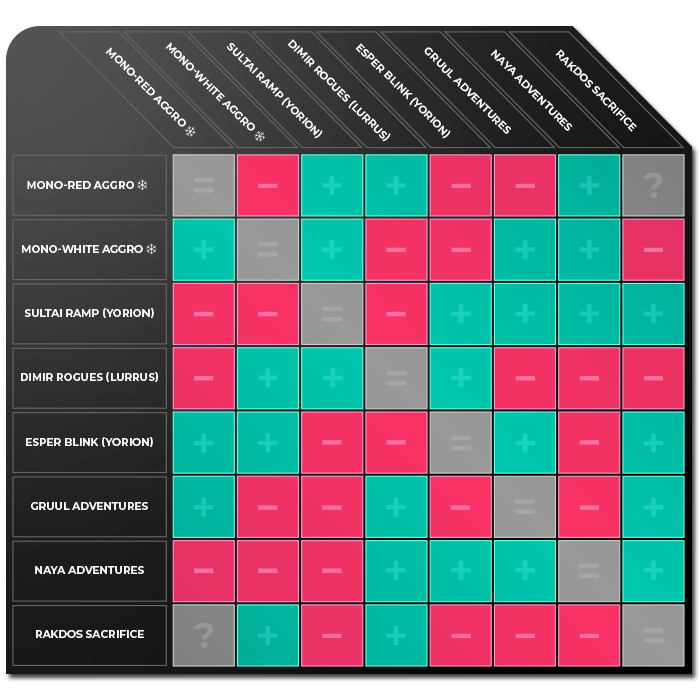
So, in the end, what did I choose for the MPL? I chose Mono-White Aggro❄.
I thought Dimir Rogues would not be a popular deck due to the perception that Mono-Red Aggro❄ was the best deck and I expected people would turn towards Mono-Red Aggro❄ as the best deck and Naya Adventures as the newest, potentially exciting kid on the block. I think my choice was a reasonable one, but I know there’s a chance I might regret it, since the deck has several bad matchups and people could just choose to play them. I’m basically gambling they won’t, or at least not in high numbers.
Regardless of what I chose, however, I would probably find myself in a similar position. There are simply no safe decks in this format, and it’s impossible to not take a risk in deck selection. Mono-Red Aggro❄ presented itself as the safest option, but even that carried some risks and I wanted to play a deck that beat it rather than the mirror. Hopefully my choice works out!

